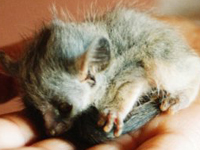

 |

|
 Bush Baby |
Bush Baby(Mammal) |
 Bush Baby Baby |
Bush Baby HabitsA nocturnal animal, as many as twenty may crowd together to sleep in an enclosed space like a hollow tree trunk. At dusk they wake & split into family groups & go searching for food. The groups forage separately all night, each group defending its own territory of 15-20 acres. A typical forging group consists of a single adult male, a pregnant female, & her young from a previous litter.
Bush babies are easy to catch, & several African tribes keep them as pets. But in 1940, bush babies were persecuted as a severe outbreak of yellow fever swept through Africa. Bush babies can harbour the virus without becoming ill themselves. Mosquitoes pick up the virus from the bush babies & pass it on to humans. with the advent of inoculations, the danger of contracting yellow fever is now greatly reduced. |
Bush Baby CommunicationBush babies communicate both by calling to each other and by marking their paths with their urine. At the end of the night, group members use a special rallying call and gather to sleep in a nest made of leaves, in a group of branches, or in a hole in a tree. |
Bush Baby BreedingBush babies mate at the end of the rainy season. In areas with one breeding season, twins are common, but where there are two breeding seasons, one baby is born at a time.
When the female is ready to give birth, she goes into hiding so that the male will not kill the young. For 3 days she remains hidden, suckling & protecting her tiny offspring. The youngsters are weaned after 6 weeks & can feed themselves by 8 weeks. At 4 months they are fully grown. In captivity, when they are fed regularly all year round, bush babies breed constantly throughout the year. |
Bush Baby Food & FeedingDuring the rainy season, bush babies eat mainly insects such as caterpillars & dung beetles, which they catch by pouncing on them. They are quick enough to catch mice & lizards. In addition, they raid birds' nests for eggs. Bush babies eat flowers, fruits, pollen, nectar, & honey from wild bees as well. In the dry season, their diet changes as food becomes scarce. They rely on the resin of acacia & albizzia trees, & they only survive in areas where these trees grow. |
Bush Baby Key Facts |
| Size |
| Height: Length: Body 6-9 in., tail 9-10 in. Newborn babies, 2 in |
| Weight: 3-10 oz. Newborn babies weigh 1/2 oz |
| Breeding |
| Sexual maturity: 8 months |
| Mating: End of rains, so depends on location |
| Gestation: 4 months |
| Number of young: 1 or 2 |
| Lifestyle |
| Habit: Family groups when foraging; larger groups when sleeping |
| Diet: Mainly insects; also flowers, pollen, honey, seeds, fruit, lizards, mice, nestlings |
| Lifespan: Up to 14 years in captivity |
DID YOU KNOW?
|
CAN'T FIND WHAT YOU'RE LOOKING FOR? CLICK HERE!!!